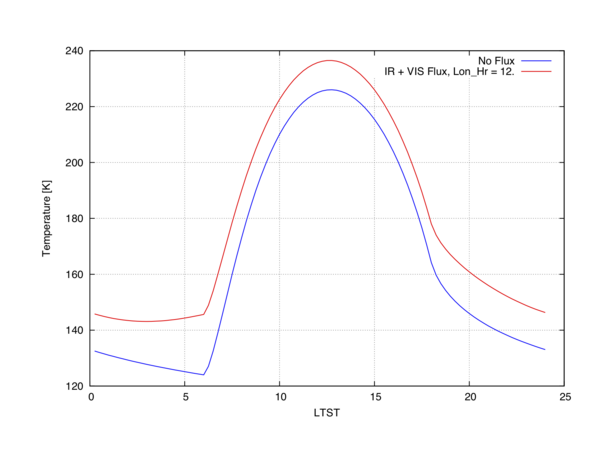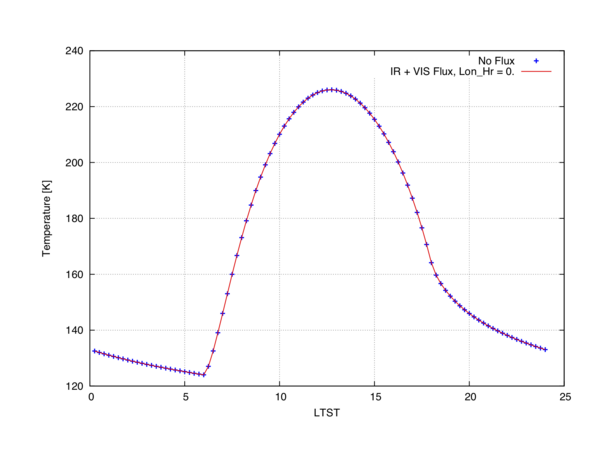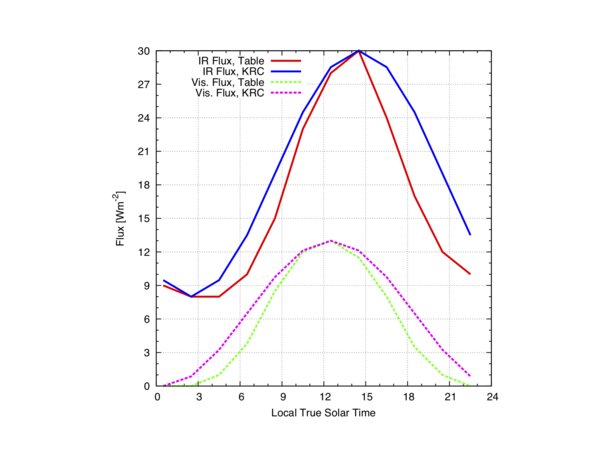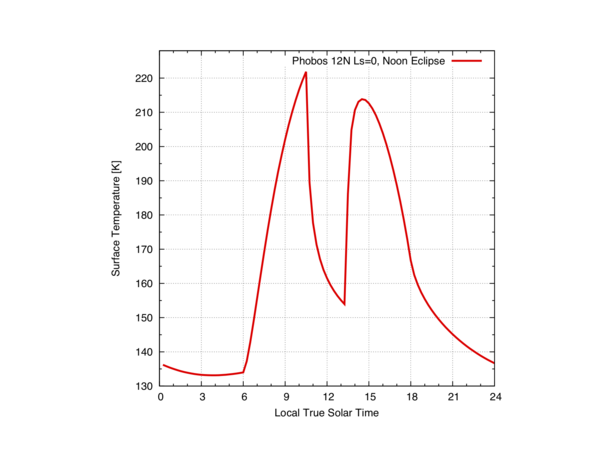KRC for Phobos
Contents |
Basic Case
Phobos models require to specify body = "Mars,Phobos"
out = krc(lat = 12. ,INERTIA = 50. ,body = "Mars,Phobos", LKofT = "T")
Note that the screen may print:
OPACITY = 0.0 as well as some other atmospheric properties values. Because PTOTAL = 0., KRC runs adequately - without an atmosphere -, but the interface prints default (Mars) atmosphere values. This will be fixed in future iterations.
Fluxes from Mars
Generally, Phobos modeling requires the addition of the visible and IR fluxes from Mars:
out = krc(lat = 12. ,INERTIA = 50. ,body = "Mars,Phobos", LKofT = "T", PFlux = "T",Lon_Hr = 8.)
...if standard flux values are acceptable (i.e., broad assumption on Mars surface temperature, and albedo). Fluxes are set with PFlux = "T", and by setting Lon_Hr.
Lon_Hr is the longitude (in Hours) of the eclipsed body surface point. Zero is opposite the sub-occulting body point; the sub-Occulting Body point is at 12. Because Phobos is tidally locked, it always presents the same face to Mars. So Lon_Hr = 12. for the sub-Mars point, and 0. for the Phobos hidden face. Note 18 < Lon_Hr%24 < 6 corresponds to the Phobos hidden face.
Alternatively, the user can provide Visible and IR fluxes versus local time (krc_planetary_flux_table() generates the input parameters). An external model or a set of dedicated KRC runs can be used to determine the IR and Visible flux versus local time, as seen from Lon_Hr and the specified latitude. The figure below shows the externally provided values ("IR External Model", and "Vis External Model", the associated sin fits fed to KRC by the interface ("IR KRC Fit", and "Vis KRC Fit"), and the difference between the external forcing and the KRC forcing ("KRC - External Model").
Note that a user might want to consider reducing the average difference between the KRC Fit and the Eternal model by fine tuning the fits.
In this case, the flux from Mars on Phobos can be formalized like this:
out = krc(lat = 12. ,INERTIA = 50. ,body = "Mars,Phobos", LKofT = "T", PFlux = "T",Lon_Hr = 8., IR = IR, Vis = Vis)
See below a comparison of the predicted surface temperature with and without Mars IR and visible shine on Phobos:
 Comparison between No Flux, and Flux at the Sub Mars point
Comparison between No Flux, and Flux at the Sub Mars point
 Comparison between No Flux, and Flux received from the hidden face (none), i.e., no forcing.
Comparison between No Flux, and Flux received from the hidden face (none), i.e., no forcing.
Mars Eclipses
To include the eclipse by Mars using standard Phobos/Mars orbital properties:
- Eclipse = "T" #forces an eclipse (Default = "F")
- Eclipser = "Mars_Mars" #Eclipser name
- Ecl_Cent_Hr = 12. #Eclipse central hour
- Bias = 0.0 #Eclipse Bias (0 => perfect alignement; 1 => partial eclipse)
- Eclipse_Style = 1
- Date = 0.
out = krc( lat = 12. ,INERTIA = 50. ,body = "Mars,Phobos", LKofT = "T", PFlux = "T",Lon_Hr = 8., IR = IR, Vis = Vis, Eclipse = Eclipse, Eclipser = Eclipser, Ecl_Cent_Hr = Ecl_Cent_Hr, Bias = Bias, Eclipse_Style = Eclipse_Style,Date = Date)
When working with Phobos eclipses, it may be beneficial to increase the time resolution of the output by increasing N24
out = krc( lat = 12. ,INERTIA = 50. ,body = "Mars,Phobos", LKofT = "T", PFlux = "T",Lon_Hr = 8., IR = IR, Vis = Vis, Eclipse = Eclipse, Eclipser = Eclipser, Ecl_Cent_Hr = Ecl_Cent_Hr, Bias = Bias, Eclipse_Style = Eclipse_Style,Date = Date, bodytype = "minor", N24 = 96 * 100)
Notes about the Default Material Properties
Comment here on the default material properties used by the interface.


